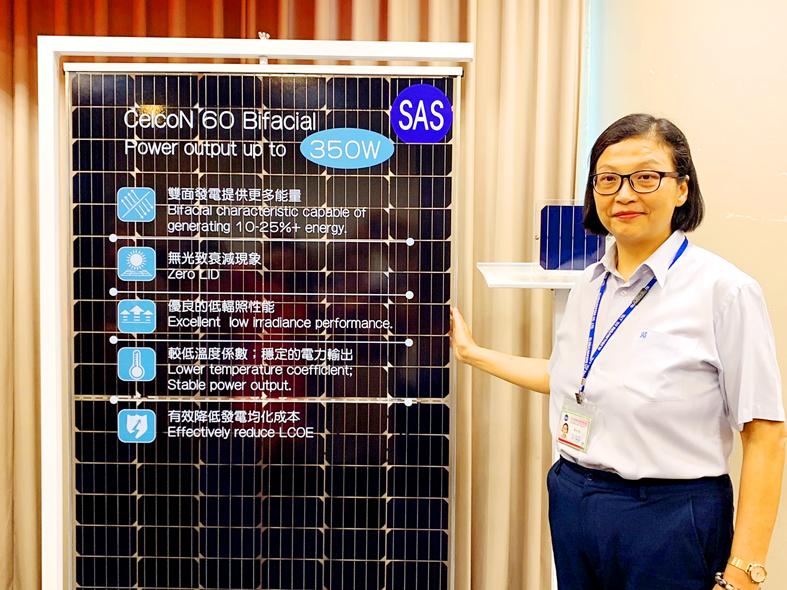Solar module maker Sino-American Silicon Products Inc (SAS, 中美矽晶) yesterday said net profit last year advanced to a historical high, benefiting from price increases and strong investment gains from its silicon wafer manufacturing subsidiaries.
The Hsinchu-based company provided a positive outlook in the expectation of strong demand for solar and renewable energy this year and next, as surging energy prices push countries to diversify energy sources, especially toward renewables.
Demand is also rising as nations set aggressive targets to cut carbon emissions or set “net-zero” timetables, SAS chairwoman Doris Hsu (徐秀蘭) said during a teleconference.

Photo: Chang Hui-wen, Taipei Times
“We see very strong growth starting this year, which will carry over through the next few years,” Hsu said.
Robust demand is also expected to bolster solar prices in the current quarter, extending from last year’s uptrend, Hsu said, adding that prices have been raised to reflect increases in the costs of raw materials, primarily polysilicone, transportation and energy costs.
Higher polysilicone and transportation costs drove down the company’s gross margin in solar products to 16 percent last quarter from 18 percent the previous quarter, the company said, adding that the rate is expected to remain flat this year.
To cope with high demand, SAS expanded solar cell capacity for the first time in about four years, with solar module capacity expansion occurring in Germany, it said.
Net profit last year expanded 0.8 percent to NT$6.82 billion (US$239.67 million), compared with NT$6.33 billion in 2020. Earnings per share rose to NT$11.62, from NT$10.82 the previous year.
Revenue jumped 12.1 percent annually to NT$68.84 billion last year, the best performance since 2018, when revenue hit an all-time high at NT$69.24 billion. About 89 percent of SAS’s revenue last year came from its semiconductor subsidiaries, mainly silicon wafer maker GlobalWafers Co (環球晶圓), 51.17 percent owned by SAS.
Gross margin climbed to an all-time high of 35.6 percent, from 34.4 percent in 2020.
“SAS achieved a positive in gross margin, operating income and cash availability in 2021. Without GlobalWafers, SAS would still be a growing and profitable company,” Hsu said when asked about investors’ concerns about the solar company’s financial performance.
Separately, SAS said that limited effects on its semiconductor operations in Japan were reported after a strong earthquake rocked northern areas of the country on Wednesday night.
“We lost several hours of work time, but operations were fully restored by noon yesterday, except silicon ingot growing,” Hsu said.
GlobalWafers operates five factories in Japan.
It has halted its ingot growing equipment for examination, Hsu said.

SELL-OFF: Investors expect tariff-driven volatility as the local boarse reopens today, while analysts say government support and solid fundamentals would steady sentiment Local investors are bracing for a sharp market downturn today as the nation’s financial markets resume trading following a two-day closure for national holidays before the weekend, with sentiment rattled by US President Donald Trump’s sweeping tariff announcement. Trump’s unveiling of new “reciprocal tariffs” on Wednesday triggered a sell-off in global markets, with the FTSE Taiwan Index Futures — a benchmark for Taiwanese equities traded in Singapore — tumbling 9.2 percent over the past two sessions. Meanwhile, the American depositary receipts (ADRs) of Taiwan Semiconductor Manufacturing Co (TSMC, 台積電), the most heavily weighted stock on the TAIEX, plunged 13.8 percent in

A wave of stop-loss selling and panic selling hit Taiwan's stock market at its opening today, with the weighted index plunging 2,086 points — a drop of more than 9.7 percent — marking the largest intraday point and percentage loss on record. The index bottomed out at 19,212.02, while futures were locked limit-down, with more than 1,000 stocks hitting their daily drop limit. Three heavyweight stocks — Taiwan Semiconductor Manufacturing Co (TSMC, 台積電), Hon Hai Precision Industry Co (Foxconn, 鴻海精密) and MediaTek (聯發科) — hit their limit-down prices as soon as the market opened, falling to NT$848 (US$25.54), NT$138.5 and NT$1,295 respectively. TSMC's

ASML Holding NV, the sole producer of the most advanced machines used in semiconductor manufacturing, said geopolitical tensions are harming innovation a day after US President Donald Trump levied massive tariffs that promise to disrupt trade flows across the entire world. “Our industry has been built basically on the ability of people to work together, to innovate together,” ASML chief executive officer Christophe Fouquet said in a recorded message at a Thursday industry event in the Netherlands. Export controls and increasing geopolitical tensions challenge that collaboration, he said, without specifically addressing the new US tariffs. Tech executives in the EU, which is

In a small town in Paraguay, a showdown is brewing between traditional producers of yerba mate, a bitter herbal tea popular across South America, and miners of a shinier treasure: gold. A rush for the precious metal is pitting mate growers and indigenous groups against the expanding operations of small-scale miners who, until recently, were their neighbors, not nemeses. “They [the miners] have destroyed everything... The canals, springs, swamps,” said Vidal Britez, president of the Yerba Mate Producers’ Association of the town of Paso Yobai, about 210km east of capital Asuncion. “You can see the pollution from the dead fish.